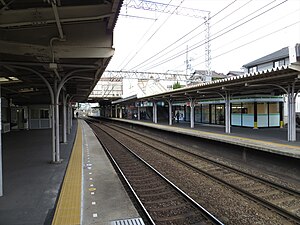|
Kintetsu-Tambabashi Station
Kintetsu-Tambabashi Station (近鉄丹波橋駅, Kintetsu Tanbabashi-eki) is a railway station on Kintetsu Railway's Kyoto Line in Fushimi, Kyoto, Japan. It is closely connected by a sheltered pedestrian bridge to Tambabashi Station on the Keihan Electric Railway Keihan Line. LinesLayoutThe station has two side platforms and two tracks.[2] Platforms
ServicesAll trains, including all limited express trains, call at this station. The typical hourly weekday off-peak service from this station is: Up trains (towards Kyoto and Kokusaikaikan)
(It may be faster to catch the first available train to Takeda and change there) Down trains (towards Shin-Tanabe, Nara, Tenri and Kashihara)
History
The route of the Kintetsu line north of this station was formerly a track of the Nara Line although the Nara Line did not have a station between Fushimi and Momoyama Stations. The former Nara Line south of this station to the merging point with the present line was totally removed and cannot be traced. While the areas of the Keihan and Kintetsu stations are limited by Tanbabashi Street to the north and Shimo-Itabashi Street to the south, before the integration of the stations in 1945, the gate of Horiuchi Station was on Shimo-Itabashi Street and the gate of Tambabashi Station was on Tanbabashi Street. Therefore, transferring passengers were recommended to change trains at Momoyamagoryō-mae Station and Fushimi-Momoyama Station, both of which were facing the same Ōtesuji Street, rather than transferring at Horiuchi and Tambabashi. When the integrated station was separated in 1960s, the stations were rebuilt with a connection bridge that provides easy access between Tambabashi and Kintetsu-Tambabashi stations. The physical connection of the Keihan and Nara Electric Railway lines and the integration of the stations were made to provide a redundancy for the railway network in consideration of a possible destruction of railway facilities by enemy attacks although the construction was completed in December 1945, after the end of World War II. The crossovers were removed after the end of through services in 1968, but the traces can be easily discovered. Adjacent stations
References
External linksWikimedia Commons has media related to Kintetsu-Tambabashi Station.
|
|||||||||||||||||||||||||||||||||||||||||||||||||||||||||||||||||||||||||
Portal di Ensiklopedia Dunia
